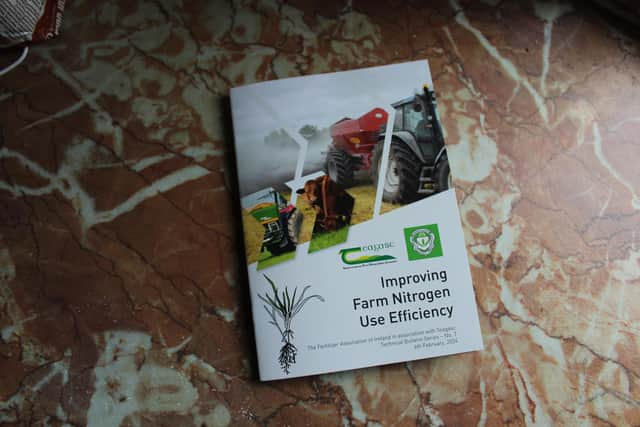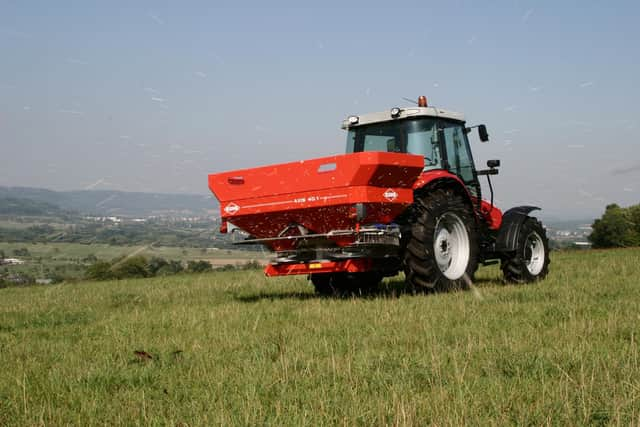Improving farm nitrogen use efficiency
and live on Freeview channel 276
Nitrogen (N) is a very essential crop nutrient, driving both crop yields and quality.
However, it must be applied at those times of optimal crop uptake.
Advertisement
Advertisement
If this is not achieved, environmental challenges will arise.


These include nitrate leaching into water courses and the emission of nitrous oxide and ammonia.
Both of these gases create major environmental problems for Irish agriculture.
Ammonia is a major air quality contaminant while nitrous oxide is a potent greenhouse gas.
Advertisement
Advertisement
The new booklet identifies nitrogen use efficiency (NUE) as the key measure, quantifying the effectiveness of applied nitrogen use throughout the growing season.


Improving NUE can help to optimise the use of nutrients on the farm, maintain and improve soil health, reduce excessive N build-up and lessen potential losses of N to the environment.
Ultimately, NUE is an indicator of of the proportion of N that is recovered in the products being sold: meat, milk and crops.
The new bulletin specifically summarises the link between N and soil health plus its interaction with other crop nutrients.
Soil pH
Advertisement
Advertisement
The most fundamental relationship is that between N and soil pH.
Correcting soil pH to the optimal level for a specific crop is the starting point for farmers to secure improved soil N levels.
High levels of soil acidity impede the mineralisation of N from soil organic matter.
Increasing soil pH through the addition of lime has the potential to increase N supply by up to 70kg/ha per annum.
Advertisement
Advertisement
Meanwhile, research carried out by Teagasc at Johnstown Castle in Co Wexford shows that maintaining higher soil pH levels reduces nitrous oxide emissions by up to 39%.
Lime is the main regulator of soil pH values.
One of the most significant trends identified by recent surveys is the confirmation that farmers across the island of Ireland are starting to use more lime.
So it would seem that, at long last, producers are starting to get back to basics.
No doubt the results coming through from the Soil Nutrient Health Scheme are encouraging farmers to spread more lime.
Advertisement
Advertisement
This is a process that could be further aided and abetted on the back of a liming grant.
Subsidies for both fencing and liming were available back in the day.
And, as the old saying goes: we should always learn from history
Lime is the most undervalued soil conditioner that we can apply to our land.
Advertisement
Advertisement
Research going back to the 19th century confirmed its ability to lift inherent soil fertility levels while, at the same time, ensuring that farmers got the best return from the manures and bagged fertilisers they used within their businesses.What’s more, lime costs a fraction of what it takes to procure and spread nitrogen, potash, phosphate and the other manufactured fertilisers on the market today.All it takes to ensure that best use is made of lime is to have a series of soil tests are undertaken, which will accurately determine the pH status of the soils across the entire scope of a farmed area.
Farm fertiliser plan
The new FAI booklet confirms the importance for farmers of completing a farm fertiliser plan.
This should be updated annually. It’s an approach that allows for the optimal use of all crop nutrients.
As part of this process, soil samples should be taken every four to five years.
Advertisement
Advertisement
This will allow for the accurate determination of soil pH, potash (K) and phosphorous (P) levels.
Maintaining optimal soil fertility levels (Index 3) will increase the efficiency of applied N from 35% on low fertility sites up to 63%, where recommended levels (Index 3) of P and K are concerned.
Incorporating clover into grass swards improves animal performance, while also reducing N requirements throughout the growing season.
Teagasc trial work has confirmed that increasing soil pH from 5.5 to 6.8 for grass/clover swards will deliver crop increases of some 13%: from 8.1t to 9.5t/h on a dry matter basis.
Advertisement
Advertisement
The application of slurry using low emission spreading systems in the spring time reduces the requirement for applied chemical N.
According to the new FAI Teagsc booklet, cattle slurry should always be recycled onto silage ground.
This approach ensures that nutrients, such as K, are kept in balance.
Having slurries and manures chemically tested is strongly recommended.
The timing of fertiliser applications is important.
Advertisement
Advertisement
N applied under the correct weather and soil conditions can be used more efficiently by crops while the risk of losses to the environment is minimised.
As a rule of thumb, fertilisers should be applied when the following conditions are met: soil temperatures are above 5.5 °C, ground trafficability is good and no rain is forecast for the following 36 hours.
The relationship between nitrogen and sulphur
Sulphur (S) is an essential plant nutrient and a key component of important amino acids.
The nutrient also plays an important role in nitrogen fixation within legume plants, including red and white clovers, peas and beans. Sulphur is also necessary for chlorpphyll formation while also promoting nodulation in legumes.
Advertisement
Advertisement
As a rule of thumb soils with 50% plus sand content and less than 3% carbon are more likely to be responsive to applications of S.
In Ireland, S levels in soils tend to be lower than is the case in other parts of Europe.
This reflects the lower atmospheric S levels found in this country.
As a consequence, Irish farmers are likely to see a positive growth response in grassland and crops when additional S is applied.
Advertisement
Advertisement
This is particularly the case in areas with free-draining soils.
Recent Teagasc research linked to S confirms that organic sources of the nutrient, such as those found in slurries and farmyard manures, are not immediately available to crops.
In addition, the application of S to soils will act to reduce nitrate leaching levels.
For example, adding S to applied slurry can reduce N leaching levels from 48kg to 26kg nitrate-N/ha.
Protected urea
Advertisement
Advertisement
Protected urea specifications include the presence of a urease inhibitor.
This can be coated on to the surface of the fertiliser granule or actively incorporated within the product during the manufacturing process.
Urease is an enzyme, present in the soil, which controls the conversion of added urea to the ammonium (NH4+) cation.
This is the key step in the conversion of urea to ammonia gas, which is subsequently lost to the atmosphere.
Advertisement
Advertisement
A number of products are recognised by the Department of Agriculture, Food and the Marine (DAFM) as effective urease inhibitors.
These are: NBPT, 2-NPT and NBPT plus NPPT.
The use of protected urea can led to significant reductions in ammonia losses from both grassland and cropping scenarios, compared to standard urea fertiliser.
In addition, the use of protected urea can support a reduction in nitrous oxide losses from grassland, compared with Calcium Ammonium Nitrate (CAN) fertiliser.
The switch to using protected urea as the main source of fertiliser N for agriculture is a key target within the Irish government’s climate action plan.
Advertisement
Advertisement
Ammonia is a pollutant that contributes to poor air quality while nitrous oxide is 298 times more potent than carbon dioxide as a greenhouse gas.
Protected urea is also a useful aid to increase NUE on both grassland and tillage farms.
Soil Health
Soil science is delivering very real and very tangible climate change mitigation measures on behalf of Irish agriculture.
This was the view very clearly expressed by Teagasc’s Dr David Wall, courtesy of his presentation to the soils conference, recently held in Belfast.
Advertisement
Advertisement
The event was jointly hosted by the British Soil Science Society (BSSS) and the Soil Science Society of Ireland (SSSI).
But according to Wall, there is no silver ‘bullet’ coming down the rack in terms of soil research programmes delivering an over-arching response to climate change.
He also recognises that much of the public debate, where farming’s response to climate change is concerned, has centred on methane emission levels from ruminant livestock.
He added: “It’s very easy for farmers to focus on their livestock. For one thing they are working with their animals on a daily basis.
Advertisement
Advertisement
“So the issue of developing the likes of a feed additive is a very tangible subject for them to comprehend.
“Making technologies of this kind work would physically require farmers to include whatever product we might be talking about into a ration on a regular basis.
“Soils, on the other hand, are much more abstract in nature.
“And, as a result, they tend not to get prominence in terms of farmers’ perception levels on a regular basis.”
Advertisement
Advertisement
Wall used his conference presentation to specifically highlight a number of soil-related management choices that will act to mitigate climate change.
Two of these include the tweaking of soil phosphorous levels and pH values.
He explained: “We know that nitrous oxide emission levels are linked to available soil phosphate values.
“And the same principle holds where soil pH values are concerned.”
Advertisement
Advertisement
Teagasc recommends an optimal pH value of 6.3 for grassland, rising to 6.5 for cereal ground.
Research has confirmed that achieving these soil nutrient targets can result in nitrous oxide emissions reducing by up to 20% relative to current figures.
Much of this is already turning out to be a good news story for Irish agriculture.
David Wall referenced the significant upturn in lime usage throughout Ireland over the past few years.
Advertisement
Advertisement
Approximately 1.2Mt of agricultural lime was applied in Ireland last year.
The comparable figure from a decade ago was 750Kt.
Courtesy of his presentation, David Wall confirmed that the European Union is actively working on the development of a soil framework directive, the recommendations within which will have a major impact on Irish agriculture.
One of the reasons why a measure of this nature has not been introduced to this point, according to the Teagasc representative, reflects the very complex nature of soils and the problems of coming up with accurate definitions.
But David Wall did confirm that soil management will be at the heart of farming’s response to climate change.
Advertisement
Advertisement
This will particularly be the case where issues such as air and water quality are concerned.
Soils will also change with the continuing impact of climate change.
This means their ability to withstand and mitigate the extremes of drought and floods – that are already apparent – will be impacted accordingly.
“There are already a wide range of soils to be found across the island of Ireland and beyond,” David Wall explained.
Advertisement
Advertisement
“Different soil types will require differing management priorities into the future.”
He added: “Soil health is of fundamental interest to soil scientists.
“It is the facet of soils that determines their capacity to mitigate the impact of climate change.
“If we fail to protect soil health, this will limit the potential of our land to deliver eco services on behalf of everyone.”